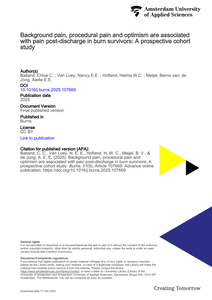Description: The Neck Pain and Disability Scale (NPDS or NPAD) is a questionnaire aiming to quantify neck pain and disability.1 It is a patient-reported outcome measure for patients with any type of neck pain, of any duration, with or without injury.1,2 It consists of 20 items: three related to pain intensity, four related to emotion and cognition, four related to mobility of the neck, eight related to activity limitations and participation restrictions and one on medication.1,3 Patients respond to each item on a 0 to 5 visual analogue scale of 10 cm. There is also a nine-item short version.4 Feasibility: The NPDS is published and available online (https://mountainphysiotherapy.com.au/wp-content/uploads/2016/08/Neck-Pain-and-Disability-Scale.pdf).1 The NPDS is an easy to use questionnaire that can be completed within 5 to 8 minutes.1,5 There is no training needed to administer the instrument but its validity is compromised if the questionnaire must be read to the patient.2 Higher scores indicate higher severity (0 for normal functioning to 5 for the worst possible situation ‘your’ pain problem has caused you).2 The total score is the sum of scores on the 20 items (0 to 100).1 The maximum acceptable number of missing answers is three (15%).4 Two studies found a minimum important change of 10 points (sensitivity 0.93; specificity 0.83) and 11.5 points (sensibility 0.74; specificity 0.70), respectively.6,7 The NPDS is available in English, Dutch, Finnish, French, German, Italian, Hindi, Iranian, Korean, Turkish, Japanese and Thai. Reliability and validity: Two systematic reviews have evaluated the clinimetric properties of 11 of the translated versions.5,8 The Finnish, German and Italian translations were particularly recommended for use in clinical practice. Face validity was established and content validity was confirmed by an adequate reflection of all aspects of neck pain and disability.1,8 Regarding structural validity, the NPDS is a multidimensional scale, with moderate evidence that the NPDS has a three-factor structure (with explained variance ranging from 63 to 78%): neck dysfunction related to general activities; neck pain and neck-specific function; and cognitive-emotional-behavioural functioning. 4,5,9 A recent overview of four systematic reviews found moderate-quality evidence of high internal consistency (Cronbach’s alphas ranging from 0.86 to 0.93 for the various factors).10 Excellent test-retest reliability was found (ICC of 0.97); however, the studies were considered to be of low quality.3,10 Construct validity (hypotheses-testing) seems adequate when the NPDS is compared with the Neck Disability Index and the Global Assessment of Change with moderate to strong correlations (r = 0.52 to 0.86), based on limited moderate-quality studies.3,11,12 One systematic review reported good responsiveness to change in patients (r = 0.59).12
DOCUMENT

Since it emerged in the early 2000's, intensive education about ‘how pain works’, widely known as pain neuroscience education or explaining pain, has evolved into a new educational approach, with new content and new strategies. The substantial differences from the original have led the PETAL collaboration to call the current iteration ‘Pain Science Education’. This review presents a brief historical context for Pain Science Education, the clinical trials, consumer perspective, and real-world clinical data that have pushed the field to update both content and method. We describe the key role of educational psychology in driving this change, the central role of constructivism, and the constructivist learning frameworks around which Pain Science Education is now planned and delivered. We integrate terminology and concepts from the learning frameworks currently being used across the PETAL collaboration in both research and practice—the Interactive, Constructive, Active, Passive framework, transformative learning theory, and dynamic model of conceptual change. We then discuss strategies that are being used to enhance learning within clinical encounters, which focus on the skill, will, and thrill of learning. Finally, we provide practical examples of these strategies so as to assist the reader to drive their own patient pain education offerings towards more effective learning. Perspective: Rapid progress in several fields and research groups has led to the emergence ‘Pain Science Education’. This PETAL review describes challenges that have spurred the field forward, the learning frameworks and educational strategies that are addressing those challenges, and some easy wins to implement and mistakes to avoid.
DOCUMENT
Pain following burn injuries can be severe and may persist after hospital discharge. The experience of pain is influenced by multiple biological and psychosocial factors. Post-discharge pain may be related to pain experienced during hospitalization as well as anxiety associated with these pain experiences. There are also protective factors; one notable example is optimism. However, the role of optimism in burn-related pain has not yet been investigated. This study aimed to describe the extent of pain measured over 14 consecutive days post-discharge and to examine its relationship with background pain, procedural pain, pain-related anxiety, and optimism. This multi-center longitudinal cohort study was conducted in five burns centres. The results showed that 50 % of the patients had a pain score ≥ 2 on a 0 – 10 scale after discharge, which on average decreased further over the next 14 days. However, a subgroup of patients maintained elevated pain levels. Patients with higher pain scores post-discharge were more likely to have experienced higher levels of background pain and procedural pain in-hospital and they scored lower on optimism. Pain-related anxiety did not independently contribute to pain post-discharge. The results indicate that patients with high pain scores during hospital admission may need specific attention regarding pain management when they leave the hospital. Furthermore, patients may benefit from optimism-inducing interventions in the hospital and thereafter.
DOCUMENT
